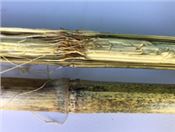|
Check Cornfields For Stalk Rots
COLUMBIA, MO.
Farmers should scout cornfields now for anthracnose and other stalk rots. University of Missouri Extension corn specialist Greg Luce says stalk rots, including anthracnose, charcoal, diplodia and fusarium, can be found to some extent in cornfields across much of the state.
Scout fields before corn matures, 40-60 days after pollination, Luce says. Check 10 sections of a field for stalk rot. Anthracnose stalk rot may not appear in the entire field.
Anthracnose shows up late in the growing season. Infected plants begin dying prematurely. Black, shiny streaks or spots appear mostly on the lower portion of the stalk. In some cases, the entire stalk blackens.
Affected plants fall when pushed. Stalks yield easily when squeezed between the thumb and forefinger. Split stalks appear discolored and rotted during the top dieback phase, also known as ghosting.
Drought and wet conditions can make plants more vulnerable to the disease. Water shortages, extended periods of cloudy weather, hail, insect infestation, low potassium-nitrogen rates, leaf diseases and other stresses during August and September increase chances of stalk rot.
“Heat this year put extra stress on the plants,” Luce says. “High nighttime temperatures are particularly stressful to corn and increase respiration and reduce defense against stalk rots.”
Yield losses can be up to 40 percent, Luce says, but losses are typically much less than that.
To avoid anthracnose stalk rot, choose resistant hybrids with good stalk strength and lodging traits. Also, rotating crops reduces stress. Luce says to use sound fertility and pest management methods.
Reduce residue in fields. Stalk rot fungi and bacteria are part of the complex of microorganisms that decompose dead plant material in the soil. They survive from one growing season to the next in soil, in infested corn residue or on seeds.
Luce does not recommend foliar fungicides particularly for anthracnose, but he says they may help indirectly by reducing stress on the plant from foliar diseases such as gray leaf spot.
Pinch stalks or push on them to check for rot and weak stalks. If the field shows more than 10 percent or more of stalk rot, harvest early to avoid lodging and yield loss.
“A big wind could easily take down the weakest fields,” Luce says. “Early harvest of fields with signs of stalk rot cuts losses. Even if you don’t suspect a problem, it is good to check fields to see which fields to harvest first and avoid surprises.”
For more information, the MU Integrated Pest and Crop Management article "Corn Stalk Rots" is available at
ipm.missouri.edu/IPCM/2013/8/Corn-Stalk-Rots . ∆

Anthracnose stalk rot shows up when stalks are split. Stalks yield easily when squeezed.
Photo by Greg Luce
|
|